Want to increase farm sales? Follow our simple marketing framework.
Whether you’re a new or established farm, you may be wondering, Where should I focus my marketing efforts in order to increase sales?
At Grapevine Local Food Marketing, this is the most common question farmers and other local food business owners ask us is. Often when people ask this question, they’ve already been spinning their wheels, or jumping from idea to idea. Farmers are some of the busiest people I know; they don’t have time to invest in work that doesn’t pay off!
Use a proven framework for farm marketing
Our overarching answer is the same for every farm, but not because every farm is the same. The details will vary from farm to farm, but the overall marketing framework is consistent, because it delivers results:
Lay the foundation
Reach new customers
Generate loyalty
It can be tempting to skip the foundation and jump in with ads because you want sales now, or get pulled in to investing all your resources in social media, or fall down marketing gimmick rabbit holes. But if you’re serious about growing your farm business, this simple framework will pay off.
Plus, you’ll have room within it to explore and plug in specific tactics, whether you’re a StoryBrand fan, eager to record videos on your new phone, or looking for a way to test out a new customer drop point location.
1. Lay the foundation
The marketing foundation is made up of three components that will make all of your other activities more effective: a basic brand, a strong website, plus email/SMS marketing.
Brand
What makes your farm special? Why will customers choose to shop with you? Start with an understanding of who your ideal customers are. Use that to focus your messaging, connect based on the values that are important to them, and build an overall identity for your farm. Logo and other visual materials are also part of creating your brand.
Website
Since this is where sales take place for most farms, it is the foundation on which every other marketing activity will build. Don’t mark this one “done” just because you have a website. It has to be a strong website.
A strong website maximizes the conversion rate among all visitors, whether they found the site via Google, word of mouth, advertising, or any other method. Conversion rate is the rate at which visitors to your website are converted to customers — or at least converted to email subscribers, so they have an opportunity to develop into customers. (If you’re the rare farm who doesn’t rely on online sales, your website’s “conversions” will be sending customers to your physical store.)
Conversion rate is influenced by content, design, and overall shopping experience.
Website content: Use text, photos, and videos to connect with potential customers, build trust, and help them see that your product is exactly what they need.
Website design: A professional, orderly design builds confidence. Photos support authenticity and help you connect on a personal level. The website needs to looks good and work well on mobile, because typically more than half of visitors will be using a mobile device.
Overall shopping experience: Make it very easy for customers to shop and to quickly understand options and fulfillment expectations — but be careful explaining how it works. Nothing scares a customer off faster than a complex explanation of how shopping works. (Consider that the Amazon home page has not featured an explanation of how online shopping works since the late 90s.) Make it easy to sign up for emails, and offer a good reason to do so.
Think about it this way: every ad dollar you spend will go further if you increase your website’s conversion rate. So rushing ahead to work on marketing before building a solid website means wasting money.
Email & SMS
You want to capture every lead and pull them into your marketing “funnel”, whether they make a purchase on the first visit or not. Automated workflows, thoughtful email newsletters, and SMS text message campaigns come together to turn leads into customers, turn customers into better customers, and nurture a two-way relationship — thereby increasing the value of all other marketing activities.
2. Reach new customers
There are many ways to reach new customers, but we start with the tactics that are most cost-effective.
SEO
If potential customers are searching in Google or other search engines, will they find your farm? People who are actively looking for products like yours will be the easiest to convert into customers.
Google visibility (aka search engine optimization or SEO) is driven by your website, with a little help from your Google business profile and other online content. You invest once — and sure you do a little upkeep, and you continue posting news — but it keeps on delivering results long after the initial investment. (Unlike Google ads, which stop delivering results the minute you stop spending money.)
Targeted ads
If you’re ready to scale, and SEO is covered, it's time to invest in advertising to reach a new wider audience. We’ve found targeted social advertising (when done the right way!) to be one of the most cost-effective methods for reaching new customers, especially for a local audience.
Every ad dollar will deliver better ROI now that you’ve built the foundation, because:
Visitors who click from ads will be more likely to convert.
Visitors who don’t purchase will still be drawn in and have an opportunity to connect (social/email), enabling further cultivation.
First-time customers will flow into a strong email/SMS system focused on helping them become strong, long term customers.
Google ads
Once your farm has saturated the local audience and is ready to expand regionally or nationally with shipping, Google ads are the next step.
Other methods
As you evaluate different methods to reach new farm customers and look at the potential return on investment, consider the value of your time along with other costs. Social media is an example of a common tactic that often has a lower than expected return on investment, depending on the strategy and the time involved.
3. Generate loyalty
Customer loyalty is a product of many factors, including:
Quality. This includes both actual quality and perceived quality. Perceived quality is influenced by everything from packaging to whether the customer chose the right cooking method. You also have an opportunity to make them feel good about their purchase and underscore its quality by reminding them what makes your farm special.
Communication. Do customers understand exactly what’s going to happen, and when? Do they feel welcome to ask questions or share complaints? Do they get an automated check-in email or survey?
Convenience. A handful of committed customers will put in extra effort to get good food, but most customers are used to convenience. Many will never make extra effort, even if they value good food. Others might be willing to make extra effort once or twice, but will struggle to order consistently if it requires too much work.
Reliability. Do orders arrive when expected? Do delivery/pickup dates get canceled? Does the order always arrive frozen? Are popular cuts available, and/or do you have a strategy to address scarcity?
Relationship. Relationships are everything in farm marketing. This brings us full circle to the email newsletters and SMS text messaging that were part of the initial foundation. Farms consistently have double or triple the average email open rate of other brands, because farm customers want that relationship. You’ll also build relationships through face-to-face interactions and social media.
A common mistake at this step is the assumption that your customers are used to confusing communication, constantly changing delivery schedules, soggy delivery boxes, or an empty storefront, so these issues are no problem. Your current customers might know the drill, but if you want to increase sales, you’re looking beyond just the diehards who will work for their food. Generating new loyal customers will take careful reflection and extra effort.
That’s it!
At Grapevine Local Food Marketing, we’ve been using this framework to grow farm sales since 2015, when as a seasoned marketer, I offered to help a farmer friend with marketing. I watched her sales triple, and decided to launch a farm marketing agency the following year. Sure, there are details to fill in and work to be done, but the overall framework really is that simple — and it works.
"Thanks Sarah. I’d like to bump up ad spend on this ad please…. We’re definitely seeing a lot more new egg and meat customers, no doubt about that. Overall, I’d say it’s definitely driving new customers and repeat orders on both fronts.”
“Yes, we’re getting a ton of shipping orders. We’ve been slammed (good thing).”
— Justin Bajema, Rebel Pastures
Ready to take your marketing to the next level?
Join the dozens of other farms who partner with Grapevine! Download a PDF for more information:











